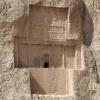Naqsh-e Rustam: Achaemenid Tombs and Sasanian Reliefs.
Commentary
The Sasanian rock-cut reliefs carved below the tombs of the Achaemenid kings (Darius I, Darius II, and Artaxerxes I) at Naqsh-e Rustam seem clearly designed to interact with their Achaemenid precedents (the tomb of Xerxes is slightly further east to this group of three and has no Sasanian relief immediately below it). Nevertheless, scholars such as Roaf have sought to encourage scepticism regarding the engagement of the Sasanian kings with the Achaemenid monarchy, preferring to see references to Achaemenid art and architecture as pointing towards ‘legendary rulers such as Jamshid who appear in the Iranian historical tradition and whom the Sasanians themselves believed were their ancestors’ (M. Roaf, ‘Persepolitan Echoes in Sasanian Architecture: Did the Sasanians attempt to re-create the Achaemenid empire?’ in Curtis et al. The Art and Archaeology of Ancient Persia (London, 1998), 6). Others, however – such as Canepa – have pointed to stylistic similarities between the Sasanian reliefs and Achaemenid art; in particular, Canepa noted of Relief 1 (apparently the last relief carved by Ardashir I and highly influential on those of his successors) that the figural style, formal aspects and features such as ‘eyes, the beard of Ōhrmazd, the horses, and the figures’ hands show that craftsmen had carefully studied the sculptures still visible in the ruins of Persepolis, about 10km away’ (M. P. Canepa, ‘Sasanian Rock Reliefs’ in D. T. Potts ed. The Oxford Handbook of Ancient Iran (Oxford, 2013), 863-865).

